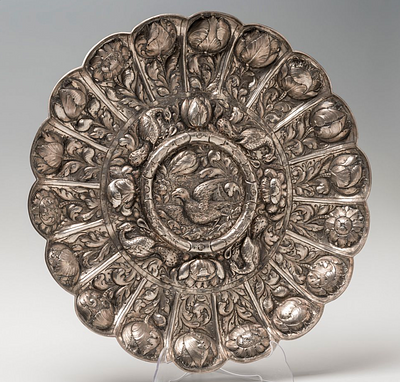CRISTOBAL RAMOS (Seville, 1725-1799). "San Franisco de Paula".
Lot 84
About Seller
Setdart Auction House
Carrer Aragó 346
Barcelona
Spain
Setdart Subastas was born in 2004 and is currently the first online art auction in Spain with solidity, prestige and reliability guaranteed by our more than 60,000 users. Setdart has a young, dynamic and enterprising team ready to successfully manage the purchase and sale of art works through custom...Read more
Categories
Estimate:
EUR€1,200 - EUR€1,500
$1,290.32 - $1,612.90
Absentee vs Live bid
Two ways to bid:
- Leave a max absentee bid and the platform will bid on your behalf up to your maximum bid during the live auction.
- Bid live during the auction and your bids will be submitted real-time to the auctioneer.
Bid Increments
| Price | Bid Increment |
|---|---|
| EUR€0 | EUR€10 |
| EUR€200 | EUR€25 |
| EUR€500 | EUR€50 |
| EUR€1,000 | EUR€100 |
| EUR€3,000 | EUR€200 |
| EUR€5,000 | EUR€500 |
| EUR€10,000 | EUR€1,000 |
| EUR€20,000 | EUR€2,000 |
| EUR€50,000 | EUR€5,000 |
About Auction
By Setdart Auction House
Jul 13, 2021
Set Reminder
2021-07-13 07:00:00
2021-07-13 07:00:00
America/New_York
Bidsquare
Bidsquare : DECORATIVE ARTS XV-XIX
https://www.bidsquare.com/auctions/setdart-auction-house/decorative-arts-xv-xix-7201
Setdart Auction House sofia@setdart.com
Setdart Auction House sofia@setdart.com
- Lot Description
CRISTOBAL RAMOS (Seville, 1725-1799). "San Franisco de Paula". Sculpture in glued fabric and papier mache. Vitreous paste eyes. With polychrome. Measures: 42 x 18,5 cm. Trained with his father (the also sculptor Juan Isidoro Ramos), Cristóbal Ramos centered his activity in Seville, where he became one of the main representatives of the local School of sculpture of the XVIII century. In the Andalusian capital he was director of the School of the Three Noble Arts. Specializing in religious sculpture, he worked masterfully with clay and glued fabrics, and was also the master of the sculptor Juan de Astorga. His style, close to that of La Roldana due to the soft and delicate flesh tones and with academicist tendencies, earned him an important place in the artistic panorama of the time. In spite of the difficulty in the realization of a catalog raisonné of his work, already initiated by Carmen Montesinos, it is known that there are numerous pieces of Ramos distributed in convents, parishes and private collections. Among his best known works are the carving of Jovellanos (1770), currently housed in the National Museum of Decorative Arts in Madrid; the María Santísima de las Aguas, belonging to the Hermandad del Museo (1772) in Seville; the Virgen del Carmen, belonging to the church of Santo Ángel (1780) in Seville; the Virgen del Rosario, belonging to the Hermandad de Montserrat (1787) located in the Chapel of Montserrat, Seville and Ntra. Sra. del Rosario, belonging to the Brotherhood of Montserrat (1787). On this occasion Cristóbal Ramos offers us a sculpture in glued fabric and papier maché representing Saint Francis of Paula (Calabria, Italy, 1416-Tours, France, 1507), hermit founder of the Order of the Minims and saint of the Catholic Church in the Italian region of Calabria. Legend has it that St. Francis became seriously ill of the eyes, reason for which his parents entrusted themselves to St. Francis, curing their son's eyes. To be grateful for the miracle, at the age of fourteen he went on pilgrimage to Assisi, thus becoming a hermit. For five years he withdrew to the mountain, feeding only on water and wild herbs, sleeping on the hard ground, with a stone as a pillow. He was canonized in 1519, only twelve years after his death, during the pontificate of Pope Leo X. In the early years of the 16th century, the Order of the Minims entered Spain, acquiring great diffusion due to the values of Franciscan preaching that they spread, which, linked to the recent canonization of the saint and his way of life and poverty, had a very strong influence among the Spanish Christian population.
- Shipping Info
-
In-house shipping available. Please inquire at admin@setdart.com.
-
- Buyer's Premium



 EUR
EUR CAD
CAD AUD
AUD GBP
GBP MXN
MXN HKD
HKD CNY
CNY MYR
MYR SEK
SEK SGD
SGD CHF
CHF THB
THB















